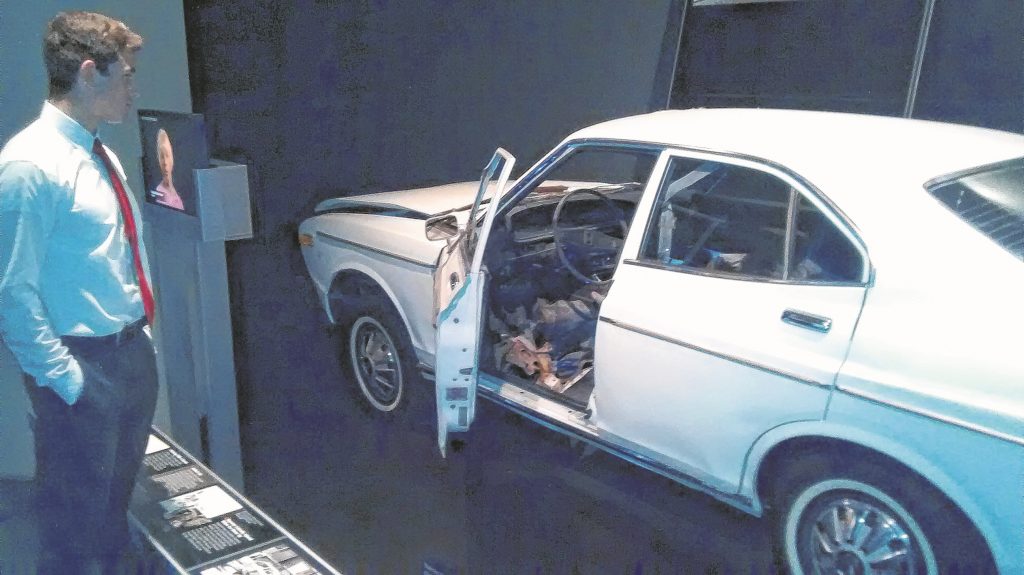
Editor’s note: Jonathan Coronel, a Corona del Sol graduate now pursuing his education at ASU, was selected to attend a prestigious think-tank program at George Washington University in Washington, D.C., coincident with the 40th anniversary of Arizona Republic reporter Don Bolles’ death in 1976.
Also in the nation’s capital is the internationally recognized Newseum, where visitors learn first-hand about the efforts of journalists around the world to protect free expression and the five freedoms of the First Amendment: Religion, speech, press, assembly and petition.
A history major and avid reader, Coronel said he felt no visit to D.C. would be complete without a trip to the Newseum, especially during the observance of Don Bolles’ life and death. His report follows.
By Jonathan Coronel
As far back as I can remember, I loved reading the newspaper. I progressed from reading the comics and sports pages throughout my childhood to voraciously reading the Wall Street Journal as a senior in high school, eager to stay up to date on the latest news in the world.
I especially had a deep admiration for investigative journalists: crusading heroes, armed with only a pen, a pad, and the relentlessness of a bloodhound in pursuing the truth in order to expose corruption and evil. Growing up with a reporter, my mother, I have seen firsthand some of the sacrifices journalists have to make to get a good story, but one man paid the ultimate price in his pursuit of the truth.
That man was Don Bolles.
By June 1976, Arizona Republic staffer Don Bolles had quit his investigative reporting beat and switched to covering the Arizona legislature. Bolles had been a good investigative reporter, exposing the Arizona mafia and corrupt politicians—he once even dared to publish the names of 200 members of the Arizona mafia.
Bolles quit his investigative reporting mostly out of exasperation with the fact that no matter how hard he tried, so many of the perpetrators of the crimes and corruption he uncovered got away unscathed. Investigative reporting had also taken its toll on the man: by age 47 he was on his second marriage and wanted to enjoy a more leisurely life than that offered by rigorous investigative journalism.
Despite all this, on May 27, 1976, Bolles received a call from a low-level criminal in the Arizona underworld by the name of John Adamson. Adamson purported to have information on a corrupt land deal involving the mafia and even such prominent Arizona politicians as Sen. Barry Goldwater.
Bolles couldn’t resist passing up such a tantalizing possibility for a story, and so he planned to meet Adamson at the Clarendon Hotel in downtown Phoenix.
Bolles arrived at the hotel and Adamson was nowhere to be seen. He had been busy, placing six sticks of dynamite inside the hood of Bolles’ car. Normally the cautious Bolles taped the hood of his car shut to prevent attacks such as this.
But this was a new car, a Datsun he had never made the effort to tape. The ensuing explosion shattered his lower body and blew the upper half of his body outside the car door. Eleven days later, Bolles died.
While tragic, Bolles’ murder only emboldened investigative journalists.
That same year, some of the country’s best journalists converged on Arizona and continued Bolles’ fact-finding endeavors, culminating in their release of The Arizona Project, which was printed in newspapers around the country.
Forty years after his tragic murder, Bolles still serves as a striking example for journalists everywhere. In the face of violence, Bolles doggedly pursued the truth—not because it was easy but because it was right. He paid the ultimate price for his pursuit, and journalists everywhere continue to look to him as what he was: a dedicated journalist who made the ultimate sacrifice to tell what he knew was an important story.
Sadly, it’s a sacrifice that seems to know few bounds in our new and increasingly brutal world.

